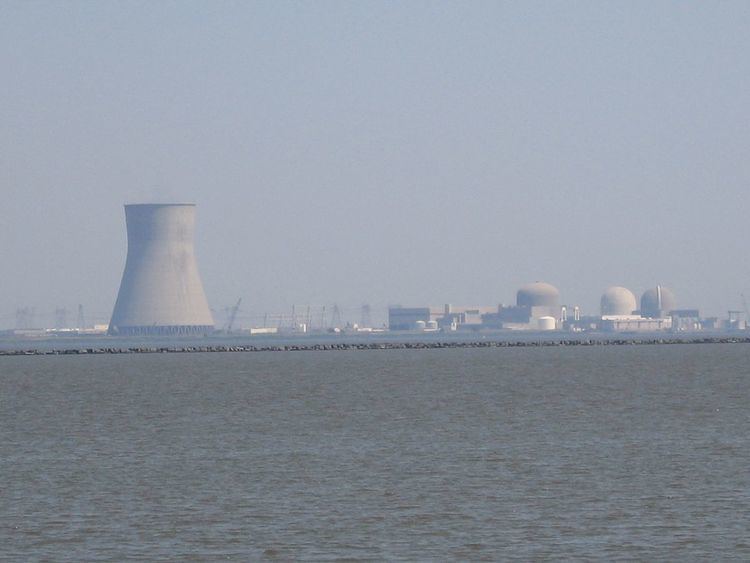Country United States Reactor type Pressurized water reactor | Status Operational Cooling towers no | |
 | ||
Commission date Unit 1: June 30, 1977Unit 2: October 31, 1981 Owners Exelon (43%), Public Service Enterprise Group (57%) | ||
Nuclear event salem nuclear power plant delaware usa
The Salem Nuclear Power Plant is a two unit pressurized water reactor nuclear power plant located in Lower Alloways Creek Township, in Salem County, New Jersey, in the United States. It is owned by PSEG Nuclear LLC and Exelon Generation LLC.
Contents
- Nuclear event salem nuclear power plant delaware usa
- Nuclear event new jersey us salem nuclear power plant 27 06 2011
- Location
- Reactors
- Surrounding population
- Safety issues
- Seismic risk
- Water use
- Notable employees
- References
Nuclear event new jersey us salem nuclear power plant 27 06 2011
Location
Salem shares Artificial Island in the Delaware Bay with the Hope Creek Nuclear Power Plant.
Reactors
The reactors, both PWRs, were built by Westinghouse, and began commercial operation in 1977 (Unit 1) and 1981 (Unit 2). The two-unit plant has a capacity of 2,275 MWe. Unit 1 is licensed to operate until August 13, 2036 and Unit 2 is licensed to operate until April 18, 2040. In 2009, PSEG applied for 20-year license renewals for both units, which were approved by the NRC in 2011.
Surrounding population
The Nuclear Regulatory Commission defines two emergency planning zones around nuclear power plants: a plume exposure pathway zone with a radius of 10 miles (16 km), concerned primarily with exposure to, and inhalation of, airborne radioactive contamination, and an ingestion pathway zone of about 50 miles (80 km), concerned primarily with ingestion of food and liquid contaminated by radioactivity.
The 2010 U.S. population within 10 miles (16 km) of Salem was 52,091, an increase of 54.1 percent in a decade, according to an analysis of U.S. Census data for msnbc.com. The 2010 U.S. population within 50 miles (80 km) was 5,482,329, an increase of 7.6 percent since 2000. Cities within 50 miles include Philadelphia (43 miles to city center).
Safety issues
The New York Times has reported that, in the 1990s, the Salem reactors were shut down for two years because of maintenance problems. Consultants found several difficulties, including a leaky generator, unreliable controls on a reactor, and workers who feared that reporting problems would lead to retaliation. In 2004, the Nuclear Regulatory Commission took on additional oversight of the Salem plants and increased the monitoring of them.
An extensive investigation by the Nuclear Regulatory Commission, and the subsequent review by hired consultants have found many minor problems, such as lack of routine maintenance and low morale among personnel, but declared the plant safe.
On Thursday, August 22, 2013, the Salem Nuclear plant was shut down after a leak of slightly radioactive water. The spill was confined to the plant's containment building, and regulators have said there is no risk to the public. The plant restarted on August 24, after having been shut down for less than 48 hours.
In May 2014 a scheduled refueling outage of Salem 2 was extended after broken bolts from a cooling pump were found in the reactor vessel. Westinghouse dispatched a team to inspect the pumps. The inspection revealed bolts in the bottom of the cooling pumps as well as the bottom of the reactor vessel. Unit 2 was returned to service on July 11, 2014.
Seismic risk
The Nuclear Regulatory Commission's estimate of the risk each year of an earthquake intense enough to cause core damage to the reactor at Salem was 1 in 90,909, according to an NRC study published in August 2010.
Water use
Both reactors use Delaware Bay as a source of cooling water. Salem units 1 and 2 have a water-intake building with a rotating screen to collect debris that is later washed off. Sometimes thick layers of grass clog the intakes and the reactors run at reduced power for weeks as a result. All of the waste heat produced in the steam cycle (about 2 gigawatts) is dumped into the bay. The resultant increase in water temperature is regulated to less than 1 °C in summer months, and to 2 °C the rest of the year. The large closed-cycle cooling tower on site is part of the neighboring Hope Creek plant and is not used by the Salem reactors.
Notable employees
Actor Bruce Willis worked at Salem Nuclear Power Plant as a security guard before pursuing acting.
